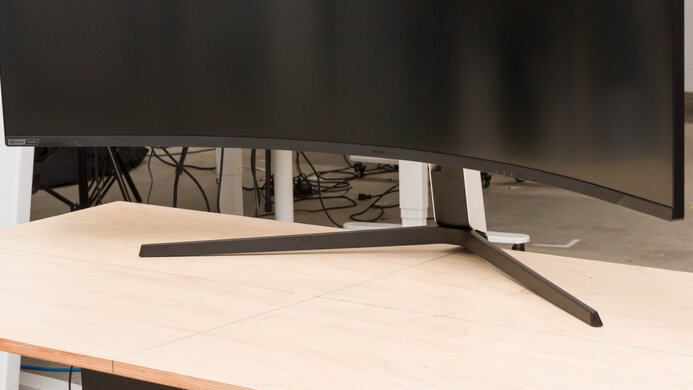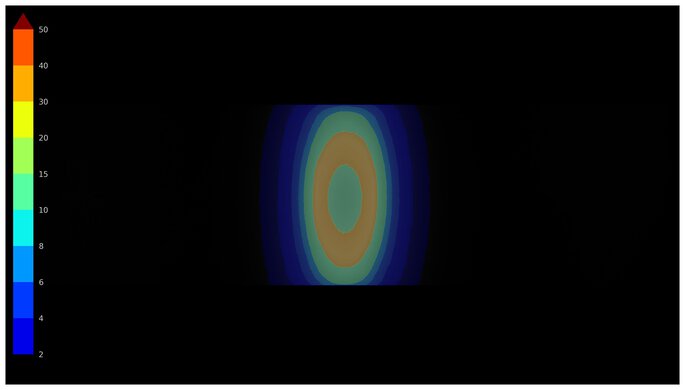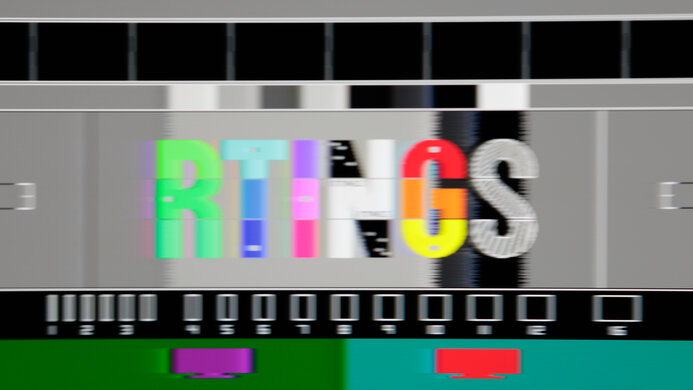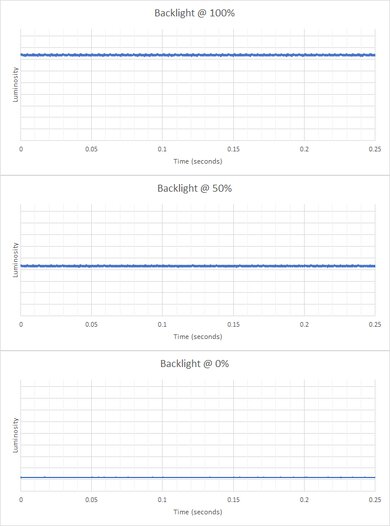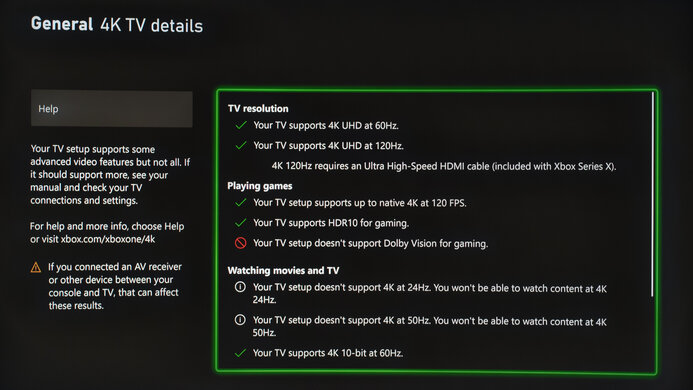The Samsung Odyssey Neo G9/G95NA S49AG95 is a 49-inch gaming monitor with a 240Hz refresh rate. It's a super ultrawide monitor with a 32:9 aspect ratio and 5120x1440 resolution, so it's the equivalent of placing two 27-inch, 1440p monitors side by side, and it has a 1000R curve. It's newer than the Samsung Odyssey G9 and includes some extra features like Mini LED backlighting with 2,048 local dimming zones. As a part of Samsung's Odyssey gaming lineup, it sits alongside the larger Samsung Odyssey Neo G9/G95NC S57CG95, and it's older than the Samsung Odyssey OLED G9/G95SC S49CG95. It has typical gaming features like VRR support and even HDMI 2.1 bandwidth.
Our Verdict
The Samsung AG900 is great for PC gaming. It has a 240Hz refresh rate with VRR support to reduce screen tearing, but there's noticeable VRR flicker with changing frame rates. Luckily, it has low input lag for a responsive feel and a consistently fast response time, but it has noticeable inverse ghosting. Lastly, it has great picture quality because it displays deep blacks and has a good local dimming feature, and highlights pop in HDR.
- 240Hz refresh rate with VRR support.
- Great native contrast ratio.
- Consistently fast response time.
- Bright highlights and vivid colors in HDR.
- Low input lag.
- Noticeable VRR flicker.
- Visible inverse ghosting.
The Samsung AG900 is great for console gaming. Although it works well with both the PS5 and Xbox Series X|S, some features don't work with either console, and the consoles don't support ultrawide gaming, so you'll see black bars on the side. That said, gaming feels responsive thanks to its low input lag, and it has a consistently fast response time, but there's inverse ghosting with fast-moving objects. Fortunately, it delivers realistic images thanks to its deep blacks, Mini LED local dimming, and bright highlights in HDR.
- Good Mini LED local dimming.
- Consistently fast response time.
- Bright highlights and vivid colors in HDR.
- Low input lag.
- Visible inverse ghosting.
- Some compatibility issues with consoles.
The Samsung AG900 is good for office use. It has a large 49-inch screen with a 5120x1440 resolution, so you can easily open multiple windows side by side. Visibility isn't an issue in most well-lit rooms as it has fantastic brightness, enough to fight glare, and good reflection handling. Unfortunately, it has narrow viewing angles and an aggressive curvature, so it isn't ideal for sharing the screen with a coworker or client.
- Enough screen space for multitasking.
- Bright enough to fight glare.
- Sharp text clarity.
- Narrow viewing angles.
- Aggressively curved screen.
The Samsung AG900 is good for content creators. The super ultrawide screen provides enough space so you can see all your work in front of you without having to scroll, but the aggressive curve isn't ideal for photo editing with straight lines. It also has oversaturated colors in the sRGB mode, so you need to calibrate it for the most accurate colors. Luckily, it delivers good picture quality in both bright and dark rooms as it gets bright enough to fight glare, and it also delivers deep blacks thanks to its good local dimming feature.
- Enough screen space for multitasking.
- Bright enough to fight glare.
- Great native contrast ratio.
- Bright highlights and vivid colors in HDR.
- Narrow viewing angles.
- Oversaturated colors; needs full calibration.
- Aggressively curved screen.
The Samsung AG900 has excellent brightness. It easily gets bright enough to fight glare, and highlights pop in HDR, too.
- Bright enough to fight glare.
- Bright highlights and vivid colors in HDR.
The Samsung AG900 has an impressive response time. Its response time is consistently fast across its entire refresh rate range, but it has noticeable inverse ghosting.
- Consistently fast response time.
- Visible inverse ghosting.
The Samsung AG900 has very good HDR picture quality. It has a high native contrast ratio, and its Mini LED local dimming feature further improves it, so it displays deep blacks against bright backgrounds without much blooming. It also displays bright and vivid colors.
- Good Mini LED local dimming.
- Bright highlights and vivid colors in HDR.
The Samsung AG900 has decent SDR picture quality. It has a great native contrast ratio, but without local dimming, it has some uniformity issues. On the plus side, it displays a wide range of colors.
- Great native contrast ratio.
- Uniformity issues without local dimming.
The Samsung AG900 has good color accuracy. Although it has a dedicated sRGB mode, colors are oversaturated, and you need to calibrate it for the most accurate colors.
- Oversaturated colors; needs full calibration.
Performance Usages
Changelog
-
Updated Jul 31, 2025:
We updated text throughout to match the new and updated tests with Test Bench 2.1, including in the Verdict section.
- Updated Jul 24, 2025: We've converted this review to Test Bench 2.1. This includes new tests for Direct Reflections, Ambient Black Level Raise, and Total Reflected Light. You can see all the changes in the changelog.
- Updated Feb 21, 2025: We've converted this review to Test Bench 2.0.1. This includes a new test result for DisplayPort 2.1 Transmission Bandwidth.
- Updated Aug 12, 2024: Updated text throughout the review according to Test Bench 2.0, mainly in the Verdict and Motion sections.
Check Price
Differences Between Sizes And Variants
We tested the 49-inch Samsung Odyssey Neo G9, also known as the Samsung AG900, and it's the only size available for this monitor. It's part of the Odyssey gaming lineup that includes other G9 models, for which you can see the differences below, but the results are only valid for the 2021 Neo G9 that we tested.
| Size | Model Name | Refresh Rate | Resolution | Panel Type | Release Year |
|---|---|---|---|---|---|
| 49" | Odyssey G9 | 240Hz | 5120x1440 | VA | 2020 |
| 49" |
Odyssey Neo G9 S49AG95 |
240Hz | 5120x1440 |
VA (Mini LED) |
2021 |
| 49" |
Odyssey OLED G9 S49CG95 |
240Hz | 5120x1440 | OLED | 2023 |
| 57" |
Odyssey Neo G9 S57CG95 |
240Hz | 7680x2160 | VA (Mini LED) |
2023 |
Our unit of the Neo G9 was manufactured in June 2021; you can see the label here.
Popular Monitor Comparisons
The Samsung Odyssey Neo G9 is a super ultrawide monitor with premium gaming features like a 240Hz refresh rate, HDMI 2.1 bandwidth, and even Mini LED backlighting that improves the picture quality in dark scenes. It competes against other 49-inch monitors with a 5120x1440 resolution, which is a niche market for people who want an immersive gaming experience instead of buying multiple monitors to place them side by side. It's a great choice if you want a monitor of this size, but if you want even better picture quality and motion handling, the Samsung Odyssey OLED G9/G95SC S49CG95 is a better choice as it has a QD-OLED panel.
Check our recommendations for the best 240Hz monitors, the best 39-49 inch monitors, and the best ultrawide gaming monitors.
The Samsung Odyssey OLED G9/G95SC S49CG95 is a newer version of the Samsung Odyssey Neo G9/G95NA S49AG95, and both monitors use different panels. The OLED G9 has a QD-OLED panel that lets it display much deeper blacks in dark rooms with perfect black uniformity, and it also has better motion handling. On the other hand, the Neo G9 uses Mini LED backlighting that gets much brighter, but the OLED G9 still delivers more vivid colors. One difference is that the OLED panel on the OLED G9 risks burn-in and has text clarity issues, so if you need something for productivity use, the Neo G9 is the better choice. However, the OLED G9 is still better for watching multimedia content and gaming.
The Samsung Odyssey Neo G9/G95NC S57CG95 is a newer monitor than the Samsung Odyssey Neo G9/G95NA S49AG95, and there are some differences. The G95NC has a larger 57-inch screen and higher resolution, so it also has better text clarity. The G95NC has better motion handling at the max refresh rate of 240Hz, but the G95NA has better motion handling at lower refresh rates. The G95NC has a few extra features, like DisplayPort 2.1 bandwidth and a KVM switch, but the G95NA performs better in some areas, like its local dimming feature that has less blooming.
The Samsung Odyssey Neo G9/G95NA S49AG95 replaces the Samsung Odyssey G9 C49G95T and upgrades it in a few ways. The major difference is that the Neo G9 has Mini LED backlighting, so it gets brighter and has much better local dimming. It also has HDMI 2.1 inputs, while the G9 has HDMI 2.0, so you can achieve a higher refresh rate over HDMI on the Neo G9. The G9 has slightly better response times, but it's not really a noticeable difference.
The Samsung Odyssey Neo G8 S32BG85 and the Samsung Odyssey Neo G9/G95NA S49AG95 are both excellent 240Hz monitors with different resolutions and aspect ratios. While the Neo G9 has an ultrawide screen with a 5120x1440 resolution, the Neo G8 has a standard 16:9 aspect ratio and 4k resolution. The HDR performance is better overall on the Neo G9 as it gets brighter and has better local dimming, so if that's important to you, go with the Neo G9.

We buy and test more than 30 monitors each year, with units that we buy completely on our own, without any cherry-picked units or samples. We put a lot into each unbiased, straight-to-the-point review, and there's a whole process from purchasing to publishing, involving multiple teams and people. We do more than just use the monitor for a week; we use specialized and custom tools to measure various aspects with objective data-based results. We also consider multiple factors before making any recommendations, including the monitor's cost, its performance against the competition, and whether or not it's easy to find.
Test Results

The Samsung AG900 is a large monitor with an aggressive curve. It has black borders on the front and a white panel in the back with a bit of a chrome trim. The stand is also black but has a white panel cover for cable management.
The Samsung Odyssey Neo G9 has great build quality. It's mainly made of plastic, but the stand is sturdy metal and supports the screen, especially for the large size. The plastic on the back feels decent, but the cover for the inputs is flimsy. Overall, it's a solid monitor, and there's nothing concerning about it.
The ergonomics are okay. It offers the most common adjustments, and it's easy to adjust for yourself, but the range of each adjustment is limited. The height adjustment doesn't fully stay in place at its lowest setting, as it slightly raises about an inch.
The back is mainly white with a bit of texture and black trim throughout. There's a ring that lights up in blue where the stand attaches to the screen. There's also a cover for the stand for cable management.
The stand takes up a lot of space, but the feet are spread apart, so you can still place stuff in front. The stand holds the monitor well, considering the screen size, but it doesn't eliminate all wobble.
The Samsung Odyssey Neo G9 has a great contrast ratio. The native contrast is very good, and the local dimming feature does an incredible job of improving the contrast. It displays deep blacks against bright highlights, which is great for watching content in dark rooms.
The Samsung Odyssey Neo G9 has a good full-array local dimming feature, and it has 2,048 zones. It does a fantastic job at improving the contrast to display really deep blacks with Local Dimming on 'High,' but it crushes some details in dark scenes. There's minimal blooming around bright objects and subtitles if you're looking at it directly in front, but it's more noticeable from the side due to the narrow viewing angles, which you can see in the video above. Fast-moving objects transition between the zones well, but the local dimming struggles to keep up with very fast objects. However, we don't recommend using the local dimming feature for productivity if you're using a browser in dark mode because the zones light up for small UI elements, which could get distracting.
We tested the local dimming with Adaptive Sync and Low Input Lag enabled, and there isn't much of a difference when using either of those modes.
We also filmed alternate videos so you can see how it performs:
The Samsung AG900 has fantastic SDR brightness thanks to the Mini LED backlighting. It easily gets bright enough to fight glare in most rooms, but it doesn't maintain the high brightness across different content as full-screen windows are dimmer. That said, the change in brightness isn't noticeable with most content.
These results are from after calibration in the 'Custom' Picture Mode with Brightness at '100' and Local Dimming on 'High.'
The Samsung Odyssey Neo G9 has excellent HDR brightness. It's bright enough for an impactful HDR experience, and while it dims small highlights a bit, they're still bright. Unfortunately, it doesn't track the PQ EOTF properly, though, as dark scenes are crushed a bit, and bright scenes are overbrightened. However, with a sharp cut-off at the peak brightness, it lets highlights get the brightest they can.
These results are with firmware 1011 in the HDR Dynamic mode with Brightness at '100' and Local Dimming on 'High.' The HDR Standard mode isn't quite as bright, with a Real Scene brightness of 741 cd/m². Older firmware isn't as bright, either.
The Samsung AG900 has a narrow horizontal viewing angle. The image looks washed out if you view it off-center, but the curved screen helps bring the edges closer to you, so you won't see many inconsistencies if you're sitting in front of the screen.
The vertical viewing angle is disappointing. The image looks washed out if you're standing above the screen looking down on it.
The accuracy before calibration is okay. It has an sRGB mode, but colors are still oversaturated. There are inaccuracies in the white balance, and even gamma is off, as most scenes are too dark. However, the color temperature is close to the 6500K target, which is great. The sRGB locks only a few settings, and other picture modes are even more inaccurate, as you can see here.
The accuracy after a full calibration is fantastic. It fixes most inaccuracies, but gamma still isn't perfect.
The Samsung AG900 has an incredible SDR color gamut. It has perfect coverage of the commonly used sRGB color space and good coverage of the Adobe RGB color space used in photo editing, but it undersaturates greens and oversaturates reds.
The Samsung Odyssey Neo G9's HDR color gamut is great. It has excellent coverage of the DCI-P3 color space used in most HDR content, but it has more limited coverage of Rec. 2020. These results are with the HDR Dynamic mode with firmware 1011, and we also measured the color gamut with HDR Standard, which performs similarly:
- DCI-P3 Coverage: 90.6%
- Tone-Mapped DCI-P3 Coverage: 90.2%
- Rec. 2020 Gamut: 67.9%
The HDR color volume is impressive. It displays bright and dark colors well, especially in the DCI-P3 color space, but it's more limited in the Rec. 2020 color space.
The direct reflection handling is mediocre. It spreads light out and has some mirror-like reflections. And because of the screen's curve, it warps objects on the screen.
This monitor does a great job at maintaining low black levels in bright rooms. Although they go up a bit, they're still fairly deep.
Since the monitor doesn't support Display Stream Compression (DSC) over HDMI, the max refresh rate is limited, and you can only get a 240Hz signal with a DisplayPort connection.
| NVIDIA | VRR Min | VRR Max |
| DisplayPort | <20Hz | 240Hz |
| HDMI | <20Hz | 144Hz |
| AMD | VRR Min | VRR Max |
| DisplayPort | <20Hz | 240Hz |
| HDMI | <20Hz | 144Hz |
On top of supporting FreeSync VRR and G-SYNC compatibility, it also supports HDMI Forum VRR.
| Refresh Rate | CAD Heatmap | RT Chart | Pursuit Photo |
| 239 | Heatmap | Chart | Photo |
| 165 | Heatmap | Chart | Photo |
| 144 | Heatmap | Chart | Photo |
| 120 | Heatmap | Chart | Photo |
| 100 | Heatmap | Chart | Photo |
| 80 | Heatmap | Chart | Photo |
| 60 | Heatmap | Chart | Photo |
The Samsung AG900 has excellent motion handling across the VRR range. Using VRR disables any of the overdrive settings, and the response time is consistently fast across the VRR range, but there's visible inverse ghosting.
The refresh rate compliance is great. Besides having low compliance at its max refresh rate, its response time is fast enough to make full color transitions before the monitor draws the next frame with 120Hz and 60Hz signals.
| Overdrive Mode | CAD Heatmap | RT Chart | Pursuit Photo |
| Standard | Heatmap | Chart | Photo |
| Faster | Heatmap | Chart | Photo |
| Extreme | Heatmap | Chart | Photo |
| VRR | Heatmap | Chart | Photo |
The CAD at the max refresh rate of 240Hz is impressive. Motion looks sharp, but there's noticeable inverse ghosting. Although the recommended overdrive setting is 'Standard,' you need to disable VRR to access the overdrive settings, but the motion handling is similar with VRR enabled.
| Overdrive Mode | CAD Heatmap | RT Chart | Pursuit Photo |
| Standard | Heatmap | Chart | Photo |
| Faster | Heatmap | Chart | Photo |
| Extreme | Heatmap | Chart | Photo |
| VRR | Heatmap | Chart | Photo |
The CAD at 120Hz is impressive. Motion is sharp, but there's noticeable inverse ghosting. Unlike at its max refresh rate, using VRR has worse motion handling than the recommended overdrive of 'Standard,' so if you're playing at 120Hz, it's better to disable VRR.
| Overdrive Mode | CAD Heatmap | RT Chart | Pursuit Photo |
| Standard | Heatmap | Chart | Photo |
| Faster | Heatmap | Chart | Photo |
| Extreme | Heatmap | Chart | Photo |
| VRR | Heatmap | Chart | Photo |
The CAD at 60Hz is impressive. The 'Standard' overdrive setting performs similarly to higher refresh rates, but there's more persistence blur.
Unfortunately, this monitor has noticeable VRR flicker with changing frame rates. It's most distracting in dark scenes, and it looks worse in person than in the video or what the score suggests. That said, you can avoid this issue if your PC can maintain consistent frame rates or if you disable VRR altogether.
This monitor has a completely flicker-free backlight, which helps reduce eye strain if you're sensitive to flicker.
Unfortunately, it has the same scanline issue as other Samsung monitors, like the Samsung Odyssey G7 C32G75T. It happens with test content like this one. We took a few uniformity photos to show you what the issue looks like:
The only way we've found to fix this issue is to reduce Sharpness, but this introduces other issues with picture quality, so it isn't a perfect fix. The scanline issue isn't noticeable in most content, though.
The Samsung AG900 has incredibly low input lag for a responsive gaming experience. There are a few quirks, though, depending on the settings used. It's important to make sure that the Refresh Rate setting on the monitor matches the refresh rate setting on your PC, otherwise the input lag increases drastically. Enabling VRR Control also causes a significant increase in input lag:
- 240Hz: 9.3 ms
- 120Hz: 19.3 ms
- 60Hz: 21.1 ms
The Samsung AG900 works well with the PS5, but there are some quirks. You have to change the aspect ratio manually; otherwise, the monitor stretches the image, but consoles don't support ultrawide gaming, so you'll see black bars on the sides. Unfortunately, even though it's possible to enable VRR, it doesn't work properly, and the screen turns black if you try to start a game with VRR enabled.
This monitor works well with the Xbox Series X|S, but you can only enable 1440p @ 120Hz if you disable VRR. You have to change the aspect ratio manually; otherwise, the monitor stretches the image. Strangely, this setting can't be adjusted if VRR is enabled, but you can disable VRR, change the setting, and then re-enable VRR, and everything works fine. That said, the Xbox doesn't support ultrawide gaming, and it doesn't support HDR with 1440p or 1080p signals, so you need to use a downscaled 4k signal for HDR to work.
For the most part, there are no serious issues using this monitor with macOS. The max refresh rate with an M1 MacBook Pro is 120Hz, as long as the refresh rate setting on the monitor is set to 120Hz. If you set the Refresh Rate setting on the monitor to 60Hz or 240Hz, you'll be locked at 60Hz. VRR doesn't work properly when you're not gaming. HDR works fine as well, but the color temperature appears to be a bit off.
The Samsung AG900 has a few extra features, including:
- Auto Source Switch +: Detects when a source is powered on and switches to that input.
- Black Stabilizer: Increases gamma so you can see opponents in the shadows in dark games.
- Crosshair: Adds a virtual crosshair for FPS games.
- Dynamic Contrast: Adjusts the contrast depending on the content.
- Infinity Core Lighting: Syncs the bias lighting with on-screen content.
It doesn't have a KVM switch, but if you want a monitor that does, check out the Samsung Odyssey Neo G9/G95NC S57CG95.





